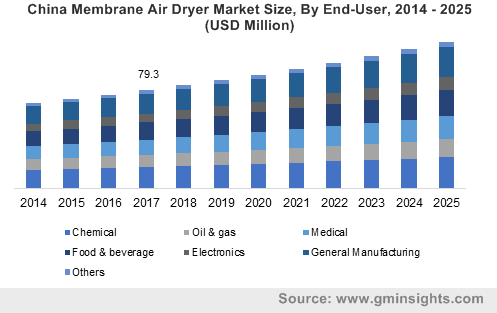Global membrane air dryers market to register a valuation of over USD 800 million by 2025, North America to crop up as a pivotal revenue pocket
Publisher : Fractovia | Latest Update: 2019-03-18 | Published Date : 2017-05-12Request Sample
The global membrane air dryers market has been receiving commendable momentum lately, pertaining to the industrial and food & beverage sectors demanding clean, dry compressed air for operations. Typically, air compressors give out air containing small amounts of water vapor which can cause damage to critical components or processes. Therefore, industries mainly prefer dry compressed air as it avoids condensation or freezing in lines and meets the needs of many processes. Membrane air dryers, in this context, pose an ideal solution as they can deliver pressure at dew points ranging from -40°F to 50°F or higher.
U.S. membrane air dryers market size by end-use, 2012-2022 (USD Million)

The product, compared to other dehumidification technologies, doesn’t require electricity and avoids cross-contamination issues. With its compact, lightweight design and absence of moving parts, the efficiency of an compressed air system is significantly improved in addition to the lower cost of maintenance. This has consequently led to a surge in product demand, amply impelling membrane air dryers industry share.
How will regions with high humidity levels increase product adoption in the coming years?
Tropical regions like Singapore and Florida typically have uniform temperatures ranging from 28 °C to 32 °C, however, the regions’ humidity levels cross well above 85% throughout the year. Hence, homes and workplaces spanning these geographies mandate efficient air conditioner (AC) systems equipped with dehumidifiers like membrane air dryers for maintaining indoor air temperature and relative humidity for offering adequate living and working conditions.
The product’s small size, easy installation and operation, compared to other available units, makes it ideal for small offices and homes, consequently paving the path for the growth of membrane air dryers market across these regions.
Speaking of the end-use scope of these components, it is pivotal to mention that membrane air dryers market is all set to register significant gains from the core industrial sectors. In pneumatic systems, compressors draw in ambient air containing some amount of water vapor which creates problems such as corrosion and bacteria growth, leading to sluggish controls or component breakdowns. Thus, membrane air dryers are needed to mitigate water issues to deliver plant/shop air, process air, instrument air and breathing air to industries.
Core verticals like the pharmaceutical, chemical, oil & gas, and general manufacturing sectors are often equipped with an environments characterized by hazardous fumes. This would quite overtly drive the demand for air dryers to protect operators, making the product an essential utility in the industrial sectors, thereby propelling the membrane air dryers industry landscape over 2018-2025.
One of the most pivotal end-use sectors of the membrane air dryers market is the F&B sector. Across this rapidly expanding domain, membrane air dryers are known to be extensively deployed to control humidity levels by absorbing moisture and condensation to gain control over various moisture related problems such as mold/fungus, moisture regains from products and packaging, moisture control in pneumatic conveying operations, product drying, coating lines and more.
The product can dramatically reduce sanitation cycle time, prevent and remove ice and frost from cold storage or spiral freezers, and prevent moisture from products such as meat, seafood, poultry, confections, dry powder, baked goods, beverage and more to keep them fresh and ready for consumers. The component’s capability to operate without electricity will help resolve the moisture issues onsite at times of power outage, majorly augmenting the membrane air dryers market size from the food & beverage sector.
North America has been touted to emerge as one of the most lucrative regional grounds for the expansion of membrane air dryers market. Increasing consumer spending in the healthcare sector along with stringent health, safety and environment codes will boost the product demand in the region. The product is also used in several food packaging equipment and machines to provide nitrogen for food manufacturing segments. Additionally, the rising demand for meat products in the region will generate favorable opportunities for core players to invest in North America membrane air dryers market.
According to the U.S. Department of Agriculture reports, meat production in the U.S. is forecast to go up 4% in 2019 to record 12.7 million tons, while exports are forecast to go 3% up to record 1.5 million tons. These estimates prove that the demand for high-efficient cold storage systems to avoid meat frosting for quality maintenance is bound to surge, which would also serve to propel North America membrane air dryers market share in the years ahead. Powered by the substantial rise in the requirement for convenience foods and the prevalence of a stringent regulatory spectrum, North America membrane dryers market size, as per Global Market Insights, Inc., is projected to register a CAGR of 4% over 2018-2025.
The global membrane air dryers industry, endorsed by a widespread end-use spectrum, stands tall as one of the most acclaimed verticals of the HVAC space. The product has been garnering renewed momentum given that it offers features like low cost, easy installation, usability in a hazardous environment, lack of moving parts and more. Being independent of electricity, membrane air dryers are also apt to be used in remote locations. As per a report by Global Market Insights, Inc. membrane air dryers market size will exceed $800 million by 2025.